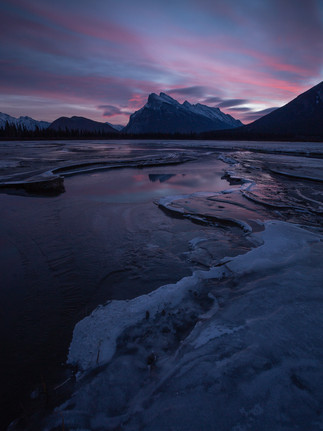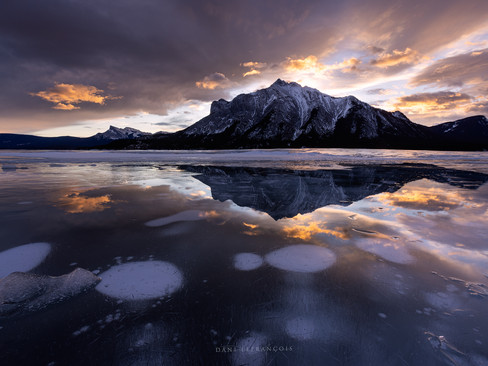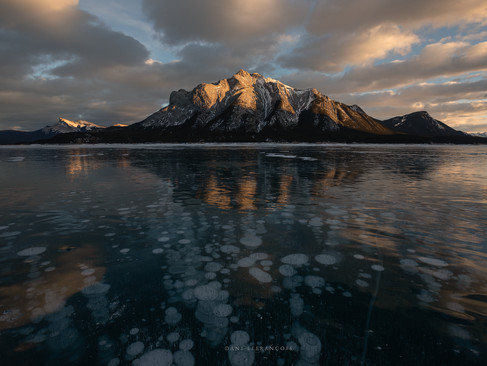Winter Photography. A how to guide to staying as warm as possible.
- Dani Lefrancois

- Jan 6, 2023
- 7 min read
Updated: Jan 7, 2023
There is something indescribably magical about winter. I'm not sure if its the snow, the frost, or the fog that makes this time of year feel so limitless. When the snow covers the landscape, a calm comes over the world and you can slow down and create magic.

However, practicing photography in the winter introduces some interesting challenges.
The biggest challenge of them all is staying warm. In this post, I am going to go over everything I've learned about keeping warm while doing photography in the long, cold winters in the Canadian Rockies.
Let's start from the bottom and work our way to the top.
Boots
One of the biggest lessons I've learned about cold weather gear is their cold rating system. If you have a pair of winter boots that are rated to -40, that is the temperature that the boots can keep you warm only when you are moving around/walking. The comfort rating for those -40 boots when you are standing still is only around -15C.
After many years of pacing, trying to keep my feet warm, I finally got a pair of Sorel -100F/-77C boots in the hopes that those boots would keep me warm when standing mostly still waiting for sunrise, or standing on frozen lakes. I can confirm that these boots work amazingly. I can stand still for well over an hour without my feet even starting to get cold.
Socks
Wool, Wool, Wool. Merino wool socks are the key to keeping your feet warm. I like to wear ski or snowboard socks that go high on the calf for some extra warmth on the really cold days.
Ultimately, what keeps your feet the warmest, is warming up the air gap between the socks and your boot. Make sure your boots aren't too tight and that you don't wear too many layers of socks to eliminate your air gap.
DO NOT wear cotton socks. Once they're wet, they stay wet, and your feet will freeze.
Pants
This is where we start talking about the most important layers; the base layers.
Here's what I use when its -40: A merino wool base layer, and a pair of fleece lined pants/leggings. If I am going to be crawling around on ice or snow, I wear a pair of insulated snowpants. This works well for those of you who get cold easily in warmer temperatures as well.
Personally the legs are the least important part for me; I prefer keeping them cold - it helps keep me from overheating. For those of you who overheat easily, on a normal day I'd just wear fleece-lined leggings, or some regular pants.
Shirts
Base layer
This is where we start to get into the most important layers. Keeping your core warm is paramount, and that's what the following layers will address.
I wear a merino wool long sleeve shirt or a merino wool t-shirt; if I'm wearing a long-sleeved shirt, I'll often pair it with the t-shirt over top.
I like the Paradox merino wool from Costco. However, in recent years their percentage of merino wool has declined. I have a few Icebreaker t-shirts that I really like that are 100% merino and oh boy, are they warm!
Fleece Layer
On top of that base layer I tend to wear a fleece layer. I have a few different varieties of thicknesses and weights of fleece. I have thinner micro fleece all the way up to the Patagonia Synchilla fleece that is fairly heavy and bulky. I also have a fleece vest that I throw into the mix when needed. This layer can also be replaced with a wool one, if you prefer.
Mid layer
This is the layer that is going to help the other two layers keep the warmth close to your body; the mid-layer is your insulating layer.
There are a few different options for this layer. Down or synthetic.
My favourite mid-layers are the Arcteryx Atom Jacket LT, the Eddie Bauer Cirruslite down, or the budget friendly Wantdo packable down jacket from Amazon. Pretty much any lightweight down puffy will work.
I also have a down and synthetic down vest that I will throw into the mix if needed.
Remember: try to keep some air between your base layer and your mid layer, because that air gap is what keeps you warm. If everything is really tight, chances are the cold will start seeping in. *Base layers are the exception - they may be close to your skin, or tight on your body.
Extra Tip: I often double up my mid layers and put my Arcteryx Atom jacket over top of my packable down layers.
Top Layer
This layer is your protection layer; the layer that is going to protect your down jackets, and be the last line of defence to keep your body heat in. This type of jacket can range from a hard shell rain jacket, to a 700fill down parka. You can make this choice when you know what you are going to be shooting.
Tip: Try to avoid wearing gear that is made for sports like skiing or snowboarding. Those jacket have been engineered to keep you from over heating while being active. They're usually breathable and have less insulation in places where you sweat - like your back, and under the arms.
For this, I have a variety of longer jackets which I call my "northern lights jackets". They range from mid-thigh to mid-calf in length, and keep me bundled when standing outside for an extended period of time waiting for the northern lights, or trains, or if its -40 and windy.
I have a Black Diamond Belay Jacket as well. What I like about belay jackets, is they're designed to keep the belayer warm as they stand mostly still while assisting a climber. As landscape photographers, we do something fairly similar when sitting on a composition waiting for the light. Belay jackets tend to be bulky, but they are so warm!
I also have a few puffy style synthetic and down-filled outer jackets. These have a more water resistant snow shedding outer fabric. If I'm going to be in an area that I can move around a lot looking for compositions, I don't need a long parka that is going to inhibit ease of movement, so this is when having a shorter length - but still super warm outer layer - is key.
Tip: You'll want to size up on these jackets as they need to go over many other layers. If you compress your other layers, they'll be less effective at keeping you warm.
REMEMBER: The air gap is what keeps you warm, and loft in a down jacket is essential to trapping the heat. If you compress your loft, you lose all the benefits of the down.
Note: I should also confess I have a jacket hoarding problem. Because of the variety of jackets I need, I can rationalize getting new ones. I take no responsibility if you become a jacket hoarder as well. Having colour options is nice =)
This leads us is in to neck warmers.
I have a love hate relationship with neck warmers. I hate having anything close to my neck because it feels like its choking me. I dislike scarves for many reasons with the biggest reason being how many bulky scarves limit range of sight when looking down at your camera.
I now have a merino wool Buff that I keep on my vehicle head rest so that it is stretched out and its been great for some added warmth.
I have tried to use the Buff over the mouth when I'm out in the stupid cold, but I simply can not handle how wet it gets from breath and then it touches my skin and it burns. I may be too much of a mouth breather in the winter to wear a mouth covering.
In extremely cold conditions, be aware that your breath will freeze on your face covering. Be mindful with this, because frostbite can happen quickly when the frozen condensation is against your skin.
Hands
Finally, the hands. This is the most common complaint when it comes to winter photography. The challenge is how to keep your hands warm while still having dexterity to operate the camera.
Here's what I do: I prioritize dexterity over warmth.
For this, I use merino wool knitted gloves. They have the best bang for warmth and dexterity. I got mine at MEC (Canada's version of REI) and they are the MEC brand.

They are touch enabled gloves so they work on my phone and on my camera's touch screen. What I keep noticing over and over again, is people wearing warm bulky gloves and they are constantly taking them off to adjust the camera, exposing their bare skin to the elements. With my technique, I never have to let my bare skin touch the elements.
Tip: Keep your hands in your pockets at every opportunity. This allows body heat to keep your hands warm, so when you have to take your hands out of your pockets to adjust the camera, they are starting out very warm. I'm able to do this because my camera is almost always on a tripod, which allows me to prioritize keeping my hands warm. You can even throw a few handwarmers in your pockets for an extra warmth boost.
Another reason why I like the knitted gloves, is because I can still feel the buttons when I use them. I can still close my eyes and feel around for buttons with these gloves on.
I always carry around a pair of really warm mittens that are about 2 sizes too big. I have small hands so I wear a small or x-small knitted gloves and have a size large extra warm mittens. I will then use my knitted gloves as liners and put them in my mittens. These mittens are bulky so I can't put my hands in my pockets. Consider putting some hand warmers in your mittens when it's super cold, so that when you put your hands back into your mittens, they're warming back up as fast as possible.
Links: https://www.mec.ca/en/product/5061-862/merino-liner-gloves and https://www.mec.ca/en/product/5054-448/slopetime-gloves
Note for those with Raynaud's Disease. Your body is fighting you when you get cold. No regular glove or mitten is going to work for you when its minus stupid outside. Invest in battery powered heated gloves.
The main reason I wanted to put hands last is because its not just gloves that are keeping your hands warm. Its your blood. If your core is warm, your hands are going to warm up faster and stay warm longer. Wearing a hat will keep your hands warmer. Wearing warm enough socks will keep your hands warmer. I often don't wear gloves until its a certain temperature because my body is so warm it is keeping my hands warm... and my ungloved hands stay in my pockets.
Next, I will be posting an in depth post on winter photography shooting that is more focused on gear, and how to not let winter defeat you. Thank you for taking the time to read this!
-Dani


































Comments